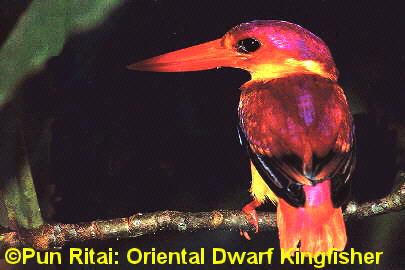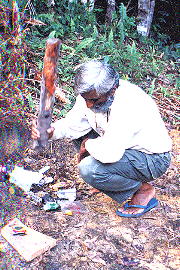
I relied entirely on The Birds of Borneo by B. E. Smythies. First published in 1960, it was the only book on the birds of Borneo available with illustrations.
 | In 1985, when I was asked to make an ornithological survey of Bako National Park, I knew very little about the birds of Sarawak. I relied entirely on The Birds of Borneo by B. E. Smythies. First published in 1960, it was the only book on the birds of Borneo available with illustrations. |
Despite this, many common birds defied identification for, amazingly, no descriptions were given for them. A visit to the Sarawak Museum Library proved equally depressing - I soon discovered that we knew next to nothing about our birds. I then decided to review and upgrade the database on the birds of Sarawak. The inevitable starting point was the existing book which was based on information derived from two main sources.
| Firstly, from a host of scientific, and some none too scientific, collectors, who went all over Borneo to kill and collect at least one specimen of every bird they saw! From this came our basic knowledge of the birds known to exist in Borneo. However, a dead bird proves little more than that it actually exists. Very little was known about their behaviour, feeding habits, breeding cycles, etc.. The second source was less destructive in nature - three generations of planters, traders and civil administrators who, when at work or while resting in their gardens, documented the activities of birds they saw in their area. |   |
It is a known fact some sample or systematic error will adversely effect the results of any research project - and anyone familiar with the birds of Sarawak will immediately see its effect on the book by Smythies. Since there were no roads, much of the interior was inaccessible. As a result, all the colonial and trading settlements were sited along the coastal fringes or on the banks of the larger rivers. Not surprisingly, more information was available on the common lowland species of the coastal regions than on the truly jungle species. Some research was done on the birds of Borneo after the Second World War and many short-term surveys have since been conducted in the more remote areas, but merely to catalogue the birds found there.
 | Even today, we know very little about some birds, except that a specimen of it exists in some Museum or another! It became apparent to me that some serious research had to be done, that we sorely needed a serious Handbook for scientific workers - especially if we hoped to evolve conservation strategies to protect the rarer birds. |
To make a detailed behavioural study, three to five months would need to be spent in each area to document the habits of every species found there. It was quite clearly too much of a tall order for one person - Sarawak State is too large to survey entirely on my own and we would needed several field teams to complete the work. After writing up a detailed project proposal, I spent the next two years looking for sponsors to fund the research - but without luck. Finally, I decided to start the work on my own, to use my own funds to finance the project. To make the best of a bad situation, I decided to first identify the problem species and the various habitat types they could be found in, then to examine these one at a time.
| Clearly the best option was to use existing tribal settlements as bases to reach sites deep in the jungle. In each study area, I would locate an old jungle hut or a clearing by a river where I could camp for about of three to five months. The camp would become my house, the clearing literally became my garden, and the birds in my new garden were all little known jungle species! Since I simply could not afford to hire any assistants, I had to live in the jungle under full field conditions for extended periods entirely on my own - this required careful planning! |  |
To save labour and costs, I took in a gas cylinder and gas cooker with me. My night lights and a laptop computer ran off a 12V car battery, recharged daily by two small solar panels that fitted snugly into my backpack. Since an unbalanced diet could effect my health, I grew vegetables for my own use at each camp, sometimes even flowers and some quick-growing fruit. At each base, once I had marked out the study areas, I got to know the birds there and studied their behaviour and nesting habits, or trapped them with mist-nets to get full descriptions and measurements.
 | Now, eight years down the road, there is a growing sense of satisfaction - in having documented most of our resident birds, including some of the rarer ones. While there are still a few elusive species to be found, the end objective has finally become less of a hopeless dream. Looking back on the past ten years, it is gratifying that I have no regrets. |
It has been a great adventure, a wonderful experience. I now have so many friends in so many longhouses and, having hiked through some of the most inaccessible parts of Sarawak, I am in better physical shape, fitter than I have ever been. Mind you, there was a bad moment in 1995 when funds ran desperately low but I was lucky in that I had good friends who convinced a local organisation into supporting my work.
   | Of course, most people are surprised that I spend about nine months of every year in deep jungle. But, having travelled extensively, I am convinced that it is safer to be alone on a jungle trail deep in the interior of Sarawak than it is to stray into some inner city areas of England, Europe or America. It is, however, a human trait to fear or be suspicious of something one is not familiar with. When the average longhouse dweller from deep in the Sarawakian jungles first hears of my work and my lifestyle, he begins by expressing surprise, and some worry for my safety as I live alone in the jungle. Once reassured that I have lived this way for a long time and am fairly competent in the ways of the jungle, one question almost invariably arises. "Aren't you afraid?" they ask. "Of what?", I ask in return, fully aware of what is going to come next. They, surprised by my reply, insist. "Of ghosts?" |
In the early days, I was often foxed by this and tried to explain in rather prosaic detail that supernatural beings really only exist in one's imagination, a view they rarely accepted - even if they were too polite to say so openly! Over the years, I had evolved a new response, one they are more prepared to accept. I look thoughtful for a while, then say quietly. "Actually, when the ghost saw me, it got frightened and ran away". The reply nearly always evokes some laughter and the matter is soon dropped.
| I remember how it was during my early visits to some longhouses. The children usually stayed well away from me, frightened, no doubt, by my beard. The women, after a while, used to tease me and the men, with exquisite courtesy and charm, would welcome me to their fireplaces. But this has changed. Nowadays, the children come tearing down the length of the longhouse, yelling out my name in welcome. The women, no longer satisfied with teasing me, also bully me, mercilessly! And spoil me too, with more food than I can possibly eat. The men? They quietly fetch an extra cup, pour out some coffee, and push the biscuits in my general direction. |   |
They no longer ask, "Where do you come from?" The question now is, "When did you return?", a tacit acknowledgement of a homecoming. A wonderful feeling, that.
| | |
| | |